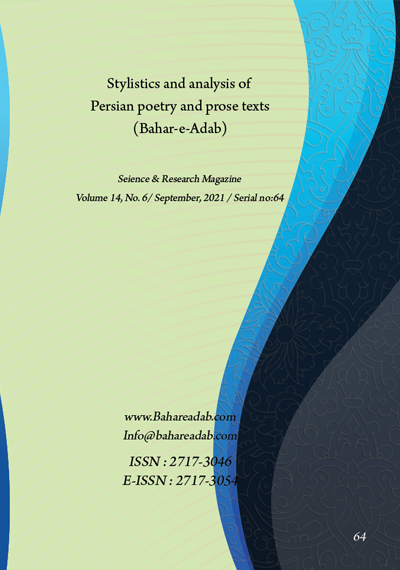- Count View : 567
- آدرس کوتاه شده مقاله: https://bahareadab.com/article_id/1141
- کد doi مقاله: Doi: 10.22034/bahareadab.2021 .14 .5690
Journal of the stylistic of Persian poem and prose
volume Number 14،
number In Volume 6،
،
issue Number 64
A Study of the Linguistic and Literary Stylistics of Farokhi Sistani
Mohammad Yavari (Author in Charge)
Abstract
BACKGROUND AND OBJECTIVES: Farrokhi Sistani is one of the prominent and capable poets of Khorasani style and one of the great composers of Persian literature, whose poems have long been known for their easy and restrained character. His divan includes ode, preference, piece, lyric and quatrain, of which ninety-two percent are owed. This article examines the stylistics of the poet"s divan at both linguistic and literary levels. The main purpose of this article was to study and explain the characteristics of Farokhi poems at two levels.
METHODOLOGY: This research was conducted in a descriptive-analytical manner.
FINDINGS: Farrokhi Sistani"s poems have been composed in ten different seas of prosody and five percent of the rhymes of his poems are current rhymes and there are fourteen verses of Morddaf in his divan. Also, the use of novel word arrays, especially various types of puns, ancient Persian verbs and words, Arabic words and phrases, and composition are among Farrokhi"s linguistic features.
CONCLUSION: At the literary level, the poet has widely used various similes in his poems, most of which are sensory to sensory similes. After that, Farokhi was considered as a type of metaphor, and after that, irony and permission were in the center of the poet"s attention, respectively. A variety of innovative spiritual industries have also been used in Farrokhi"s speech, with the highest frequency being the array of contradictions and the lowest being the array of guarantees.
Keyword
Farrokhi Sistani
, Stylistics
, Linguistic level
, Literary level
, Divan
, Ode
- Bahar, Mohammad Taghi. (1970). Stylistics, eighth edition, Tehran: Amirkabir, p.259.
- Barani, Mohammad. (2002). Music of Farrokhi Poetry, Journal of Persian Language and Literature, Sistan and Baluchestan University, first year, autumn and winter, pp. 19-50.
- Divan Farrokhi Sistani. (1992). by Mohammad Dabirsiyaghi, fourth edition, Tehran: Zavvar.
- Forouzanfar, Badi-ol-Zaman. (1972). Speakers and orators, second edition, Tehran: Kharazmi, p.124.
- Fotouhi, Mahmoud. (2012). Stylistics, Theories, Approaches and Methods, Tehran: Sokhan, p.324.
- Fotouhi, Mahmoud. (2007). Image Rhetoric, Tehran: Sokhan, p. 91-92.
- Haghshenas, Ali Mohammad. (1991). Literary and linguistic articles, Tehran: Niloufar, p. 139.
- Mallah, Hossein Ali. (2006). The link between music and poetry, second edition, Tehran: Faza, p.81.
- Oveysi Kahkha, Abdul Ali; Abbasi, Mahmoud and Ettehadi, Hossein. (2015). Repetition and its rhetorical values in the poetry of Farrokhi Sistani, Persian Language and Literature Research, No. 34, pp. 88-65.
- Shafiee Kadkani, Mohammad Reza. (1995). Poetry Music, Fourth Edition, Tehran: Agah, p. 62, 307.
- Shafiee Kadkani, Mohammad Reza. (1991). Images of Imagination in Persian Poetry, Fourth Edition, Tehran: Agah, p. 486, 489.
- Shafiee Kadkani, Mohammad Reza. (2008). Persian Poetry Periods, Fifth Edition, Tehran: Sokhan, p. 19.
- Shamisa, Sirus. (1997). Generalities of Stylistics, Fourth Edition, Tehran: Ferdows, p.153.
- Vahidian Kamyar, Taghi. (2000). Innovative from the point of view of aesthetics, Tehran: Dustan, p.28.
- VataVat, Rashid al-Din Mohammad. (1983). Hadaiq al-Sahar in the Minutes of Poetry, edited by Abbas Iqbal Ashtiani, Tehran: Sanai and Tahoori Library, p. 87.
- Yousefi, Gholam Hossein. (1989). Farrokhi Sistani: A Discussion on the Description of His Life and Times and His Poetry, Second Edition, Tehran: Elmi, p. 87, 558.

